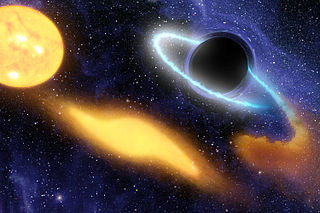Observations of the Night Sky Led to the Discovery of the Black Hole
by Ashley Luse, age 11

A
fantastic discovery was made one night in 1844 by German astronomer,
Friedrich Wilhelm Bassel. Bassel discovered a dark and mysterious
force in the universe, now known as the black hole.
While
using an advanced microscope to observe the brightest star in the
galaxy, the ‘dog star’ Sirius, Bassel made a curious observation.
Bassel expected his measurements to show the star moving in a
straight line. Instead, after days of observation, he noted that the
star seemed to be moving irregularly. He hypothesized this movement
was caused by some gravitational pull on the star that could not be
seen, which led to the theory of black holes.
The
experiments Bassel did to explore the idea of black holes led to
great discoveries, including the life stages of a star. Ninety
percent of stars become black holes after progressing through their
life stages. During the first phase of a star’s life, it is
comprised of two elements, hydrogen and helium. When those two
elements fuse together, great amounts of energy are released in a
nuclear process.
Then
outer layers of the star begin to slowly dissipate, until all that
remains is the extremely dense core. One example of a star in its
first phase is our sun. Fusion of hydrogen and helium continues, and
over time the core of the star grows denser. At the same time, layers
of the star expand, and it grows in size and turns a crimson color.
The star is then known as a “Red Giant.”
After
the star reaches this point, it emits a different wavelength of
light. It is now called a “White Dwarf.” This type of star is
what helped Bassel with all of his other discoveries. The final stage
is when the “White Dwarf” collapses completely, creating the
densest, smallest version of the star - a black hole. A black hole is
millions of times smaller, but its gravitational pull is extremely
powerful. So powerful, in fact, that any object near a black hole
will be sucked into it.
There
has been much speculation about the nature of black holes. While some
scientists think that any object drawn into a black hole will simply
burn up, others believe that they hold the future key to traveling
through time and space itself.
[Source:
Greatest
Mysteries of the Unexplained
]
|

